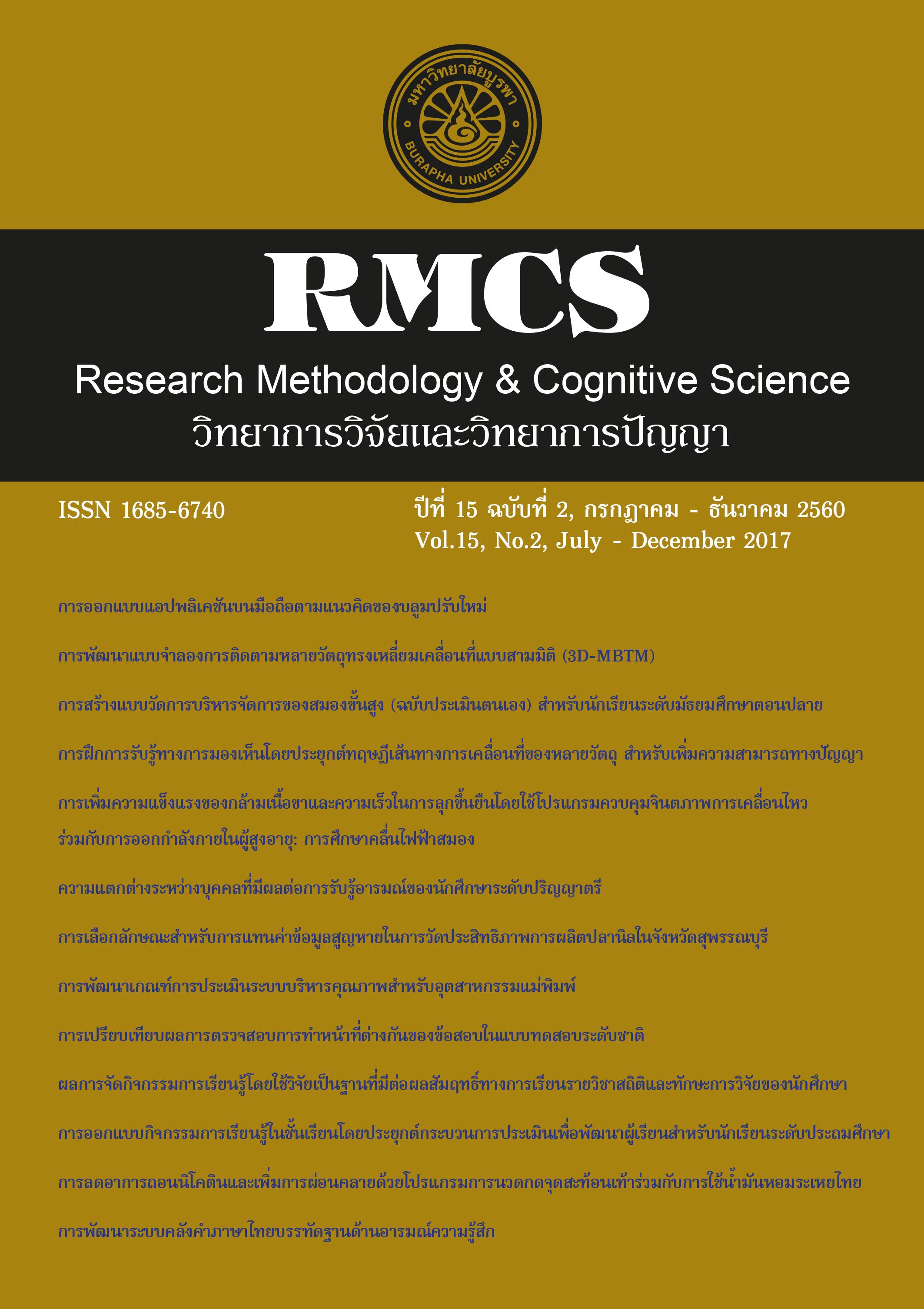Designing Classroom Learning Activity by Implementing a Formative Assessment Process for Primary School Students
Main Article Content
Abstract
Appropriate learning activities must be designed and conducted together with an assessment
process. Therefore, this research aimed to design the classroom learning activities by implementing
a formative assessment process for primary school students and to investigate the effectiveness
of classroom learning activities developed by the researcher. The outcomes were considered from
the understanding of teachers in designing activities, the results of analytical review of teaching
and learning behaviors, the interaction in a classroom between teacher and students, students and
students, and the learning outcomes from students who participated in the learning activities. The
target group consisted of 5 teachers and 14 grade-one students from Ban Kokaew School and 8
teachers and 21 grade-four students from Ban Du School, Surin Province. The research instruments
included the assessment of understanding in designing activities form, the classroom behavior
analysis form for assessing the target behaviour from video recording, and the interview form. Data
analyses were done by using means and standard deviations. The qualitative data were analyzed
by means of content analysis.
Results were as follows:
1. The classroom learning activities which integrated with formative assessment composed of six
steps; 1) setting learning goals, 2) setting learning success criteria, 3) performing the activities and
finding/considering the learning outcome evidence, 4) assessing the learning outcomes, 5) providing
learning feedback, and 6) summarizing the learning outcomes.
2.The designing of classroom learning activities comprised sevenprinciples; 1) initiating
interesting problem, motivating curiosity, and searching for answer, 2) performing tasks by themselves
and brainstorming with the group, 3) creating and mutually contributing to the projects, 4) liking
to real-life situation and utilizing local medium, 5) integrating the subject contents, 6) relating to
brain functions, and 7) active learning activities.
3.The developed classroom learning activities consisted of eight modules (24 subjects) for
grade one and four students were suitable to be used.
4. The outcomes of the developed classroom learning activities brought about dynamic classrooms
and mutual learning. These changes improved teachers’ teaching and students’ learning behaviors.
Furthermore, the classroom interaction between teacher and students and among students groups
were also enhanced as well as students’ academic achievement. In addition students, teachers,
parents, and school principal have more positive attitudes toward learning activities.
Article Details
References
สถานศึกษา สังกัดสำนักงานคณะกรรมการการศึกษาขั้นพื้นฐาน. วารสารวิชาการมหาวิทยาลัยอีสเทิร์นเอเซีย ฉบับ
สังคมศาสตร์และมนุษยศาสตร์, 5(1), 54-62.
โชติมา หนูพริก. (2557). การวัดและประเมินผลในชั้นเรียน: การประเมินเพื่อพัฒนาการเรียนรู้. วารสารวิชาการ, 7(3), 3-17.
พนม พงษ์ไพบูลย์. (2558). มาปฏิรูปห้องเรียนกันเถิด. วันที่ค้นข้อมูล 1 กรกฎาคม 2559, เข้าถึงได้จาก
http://www.moe.go.th/moe/th/news/detail.php?NewsID=42226&Key=news_research
พิชิต ฤทธิ์จรูญ. (2559). การประเมินเพื่อพัฒนาการเรียนรู้. วารสารศึกษาศาสตร์ มสธ, 9(1), 1-17.
วาทิณี จิตรสำรวย, เสรี ชัดแช้ม, ภัทราวดี มากมี และ สิริกรานต์ จันทเปรมจิตต์. (2560). การพัฒนาเกณฑ์การประเมินเพื่อ
พัฒนาผู้เรียนของครูระดับประถมศึกษา. วิทยาการวิจัยและวิทยาการปัญญา, 15(1), 102-116.
วิจารณ์ พานิช. (2555). งานสำคัญของการศึกษาไทยสร้างทักษะให้ผู้เรียนพร้อมสู่ศตวรรษที่ 21. School in focus,
4(11), 6-7.
วิจารณ์ พานิช. (2557). การประเมินเพื่อมอบอำนาจการเรียนรู้. กรุงเทพฯ: สำนักพิมพ์สานอักษร.
สุเทพ อ่วมเจริญ. (2554). การพัฒนารูปแบบการประเมินการเรียนรู้ของนักเรียนและการสอนของครูระดับการศึกษาขั้น
พื้นฐาน. วารสารศิลปากรศึกษาศาสตร์วิจัย, 3(1), 24-37.
หริสา ยงวรรณกร, สมชาย เทพแสง และถนัด อนันต์. (2558). การปฏิรูปการเรียนรู้ของครูในยุคโลกาภิวัตน์.วันที่ค้นข้อมูล
1 กรกฎาคม 2559, เข้าถึงได้จาก http://ejournals.swu.ac.th/index.php/EAJ/article/viewFile/4122
เอกพัน แป้นไทย. (2559). ปั้นครูแห่งอนาคต สร้างห้องเรียนศตวรรษที่ 21 เกิดขึ้นจริง-ยั่งยืน บนเวที TELS 2016.
วันที่ค้นข้อมูล 1 ธันวาคม 2559, เข้าถึงได้จาก http://www.77jowo.com/contents/2855
Anton, H., Kari, S.B., Olga, D.B., & Kristine, L. (2012). Formative Assessment and Feedback: Making
Learning Visible. Studies in Educational Evaluation, 38(1), 21–27.
Bailey, A., & Heritage, M. (2008). Formative assessment for literacy, grades K-6: Building reading and
academic language skills across the curriculum. California: Corwin Press.
Heritage, M. (2010). Formative Assessment Making It Happen in the Classroom. California: Corwin Press.
Joyce, B., & Weil, M. (1996). Models of Teaching. (5thed.). Boston: Allyn and Bacon.
McMillan, J. H. (2008). Formative Classroom Assessment: The keys to Improving Student Achievement. In J.
McMillan (Ed.), Formative Classroom Assessment (pp. 1-7). New York: Teachers College.
Organisation for Economic Co-operation and Development. (2005). Formative assessment:
Improving learning in secondary classrooms. OECD Publishing, 2005.
